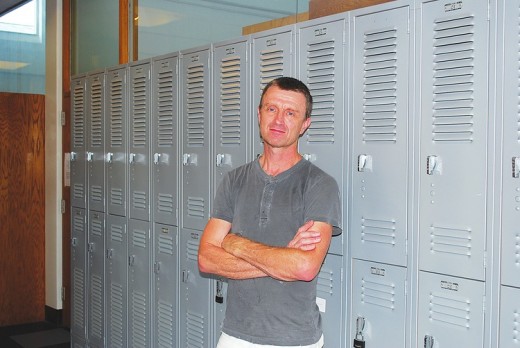Electrostatic painting gives new life to old furnishings
Green is more than just a color choice when it comes to electrostatic painting. Old office furniture can be repainted to look like new with this factory-finish painting technique, and it can be done at a fraction of the cost of traditional methods.
Pat McMurry, interior finish contractor with Missouri Painting, transformed outdated, faded and chipped lockers in the Catherine Webb Art Studios building at Stephens College into a modern, gleaming silver. With this project, the use of protons and electrons moved from the science lab into the hallway.
“The electrostatic sprayer is called a Ransburg No. 2, and it is really the only sprayer like it in the industry,” McMurry said. “It charges the paint with a positive charge, and then you ground whatever object it is that you want to paint. Then the magnetic charge — just like a magnet — attracts the paint to the surface that you’re going to paint.”
Although many things are grounded just by being in contact with the earth, McMurry said to ensure a target is safely grounded, he takes a wire and connects it to a piece of plumbing in the building. “This is always a good source of a ground,” he said. “You then ground the paint sprayer, and you also ground the target that you’re painting.”
Electrostatic painting is different from conventional painting in a number of ways. “The way it works that really makes it different is the paint is spun in a bell — a circular cylinder — and it comes out of the sprayer with almost no directional velocity,” McMurry said. “Essentially, it’s just a mist that slowly comes out of the sprayer, and then the electric charge pulls the mist onto the target’s surface. In other sprayers, the paint shoots out with a velocity, and that causes overspray to go all over the building.”
McMurry said to obtain a smooth factory finish, epoxy is the kind of paint to use as it creates overspray with any other kind of sprayer. That spray then drifts and gets on other surfaces in the building. “If I would have sprayed these [lockers] with a conventional sprayer, everything would have been silver,” he said. “We sprayed this with the electrostatic sprayer, and we masked the floor out about three feet because the floor is also grounded, but there was no overspray; just a few feet around what you are spraying is sufficient to cover it.”
McMurry, who also owns McMurry Paper Hanging LLC, which does commercial interior refinish work, said he became interested in the process of electrostatic painting three years ago. LeAnne Fields, an interior design instructor at Stephens College, suggested McMurry look into the process because the closest contractor at the time was in St. Louis.

In finding a niche for his business, McMurry is helping his clients cut expenditures. There are large savings found in revamping old furniture as opposed to purchasing new. An example of cost efficiency is the recent repainting of the lockers at Stephens College. “To have replaced all of these lockers would have cost three or four times what it cost to paint them,” McMurry said. “There’s also a ‘green’ component to it by not having to buy a bunch of new lockers. All that steel and the manufacturing process, all that’s eliminated by using this efficiently, by using it over.”
In terms of being “green” and environmentally mindful, McMurry said refinishing old office furniture is a part of it. “Another thing that makes it efficient is the transfer efficiency, the amount of paint that you run through your sprayer compared to how much actually goes onto what you’re painting,” he said. “With the electrostatic process, it’s around 95 percent, so almost all of your paint goes onto your project. It’s as low as 30 percent with other kinds of spray.”
McMurry said he doesn’t limit the types of projects he will take on, “but the kind of projects that fit well within the electrostatic process are projects that are hard to remove from the job site and projects that require an epoxy coating.” This process is the most cost-effective way to paint these projects as clients do not have to disassemble, move, repaint and then move the refinished furniture back to its original location.


